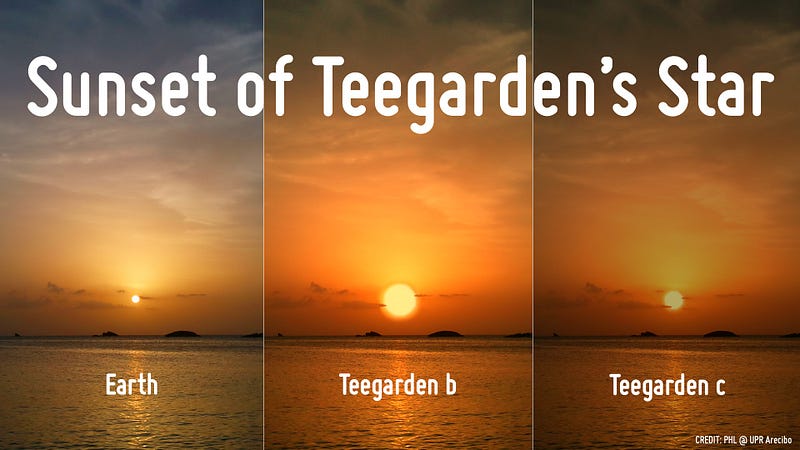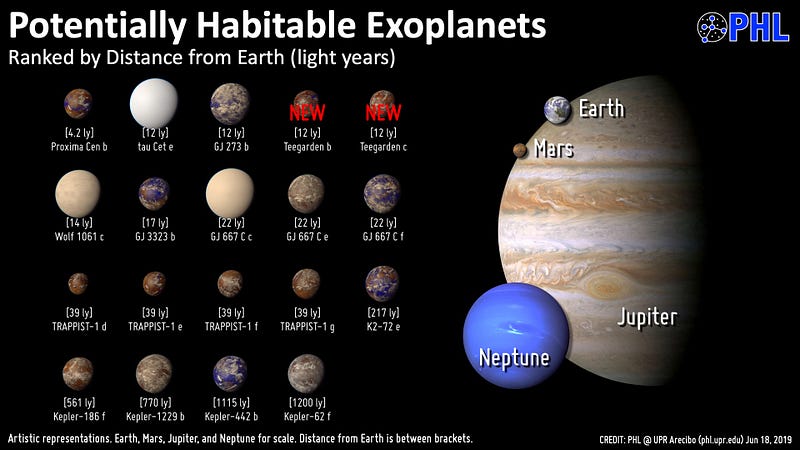Exciting Discoveries: Earth-Like Planets Around Teegarden’s Star
Written on
Chapter 1: The Discovery of Teegarden’s Star
Recent findings reveal that two planets, slightly larger than Earth, have been identified orbiting Teegarden’s Star, a red dwarf star located merely 12.5 light years from our planet. A meticulous three-year study has uncovered these worlds, which may possess conditions suitable for life.
Teegarden’s Star, our solar system's neighbor, remained undetected until its discovery in 2003. This small, dim star has a surface temperature of approximately 2,700 degrees Celsius (4,900 degrees Fahrenheit) and has only about 10% of our Sun's mass, making it challenging to observe.

The sunsets on Teegarden b and c promise to be breathtaking, owing to their close proximity to their parent star. Mathias Zechmeister from the Institute for Astrophysics at the University of Göttingen describes, “These two planets bear resemblance to the inner planets of our solar system. Slightly heavier than Earth, they orbit within the so-called habitable zone, where liquid water could exist.”
Teegarden’s Star is remarkable as it is the smallest star where scientists have successfully measured the mass of an orbiting exoplanet. At over eight billion years old, it is the 24th closest star to Earth and ranks as the fourth-closest system with potentially habitable planets.
Section 1.1: Conditions for Life on Teegarden b and c
“The closest planet, Teegarden b, has a 60% likelihood of maintaining a temperate surface environment, with expected temperatures ranging from 0° to 50°C. Assuming a terrestrial-like atmosphere, the average temperature would be approximately 28°C (82°F), though this could vary based on its composition,” notes Abel Mendez from the Planetary Habitability Laboratory (PHL) at UPR Arecibo.
Teegarden b is just a tad more massive than Earth and completes an orbit around its star in 5.9 days. Researchers have assigned it an Earth Similarity Index (ESI) score of 95%. However, strong solar flares from its star pose a significant threat to the potential for life, as they could strip away the atmosphere or any oceans that might develop.
Life appears even less likely on Teegarden c, which takes 11.4 Earth days to orbit its star. Although it is slightly larger than Teegarden b, its surface temperature is estimated at around -47 degrees Celsius (56 degrees Fahrenheit). These harsh conditions, akin to those found on Mars, suggest only a 3% chance of a temperate climate, with an ESI of 68%. A thick atmosphere rich in greenhouse gases could potentially elevate surface temperatures on this planet.
Subsection 1.1.1: Discovering Exoplanets
Most exoplanets are detected using the transit method, where astronomers observe dips in brightness as planets pass in front of their stars. However, the planets orbiting Teegarden’s Star were discovered through the radial-velocity (R-V) method, which involves monitoring stellar movements indicative of orbiting planets. This comprehensive study involved over 200 observations, resulting in the identification of these new worlds. This technique has previously led to the discovery of about 800 exoplanets across various solar systems.
“This achievement marks a significant milestone for the Carmenes project, aimed at locating planets around the lightest stars,” remarked Ansgar Reiners from the University of Göttingen.
The first video titled "We Just Discovered 2 Earth-Like Planets In Nearby Teegarden Star" provides an overview of this groundbreaking discovery, detailing the characteristics and potential habitability of these new worlds.
Section 1.2: Astronomical Perspectives
Given the alignment of our solar system with Teegarden’s Star, if there were extraterrestrial astronomers on these planets, they would likely be able to detect Earth through the transit method.
The second video, "Exoplanets Discovered In Habitable Zone of Teegarden's Star - 'Only 12.5 Light Years Away'" discusses the implications of these discoveries on our understanding of potential life beyond Earth.
Chapter 2: The Broader Universe of Exoplanets
As of now, around 4,000 exoplanets have been cataloged, with thousands more pending confirmation. A substantial number of these discoveries arose from data collected by the now-retired Kepler spacecraft. Currently, the Transiting Exoplanet Survey Satellite (TESS) is conducting an all-sky survey for exoplanets while observing Earth from a high-Earth orbit (HEO). In its initial three months, TESS identified three exoplanets that were later confirmed by Earth-based astronomers. Notably, NASA recently announced the discovery of a planet comparable in size to Earth.
The identification of two planets around Teegarden’s Star brings the total number of known exoplanets residing in temperate zones—where temperatures allow for liquid water—to 52. Of these, 19 possess similar masses to Earth and are believed to have rocky surfaces, indicating the potential for Earth-like environments.

As stated by Adam Frank, author of "Light of the Stars: Alien Worlds and the Fate of the Earth," “Based on exoplanet data, astronomers can confidently assert that one in five stars is likely to have a planet where life as we understand it could potentially develop.”
Thus, as you gaze at the night sky, consider this: if you randomly select five stars, it’s plausible that one of them hosts a planet in its Goldilocks zone, where liquid water may flow, and life could already exist.
Current astronomical beliefs suggest that most stars are accompanied by families of planets, implying that Teegarden’s Star might also harbor undiscovered worlds. The discovery of Earth-like planets orbiting such a nearby star hints at the many unseen worlds still out there. As we deepen our understanding of the cosmic neighborhood surrounding our Solar System, the prospect of finding life on other planets seems increasingly likely.